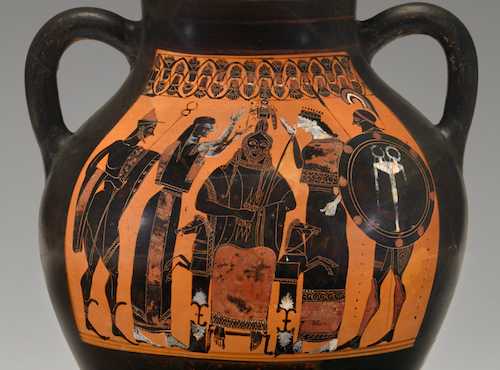OVERVIEW OF THE COLLECTION
The Virginia Museum of Fine Arts collection of ancient Mediterranean art is the largest public collection of Ancient Art between Baltimore, MD and Atlanta, GA. The museum’s holdings span more than 5,000 years of human history, from Pre-Dynastic Egypt in the 4th millennium BCE. through the fall of the Byzantine Empire in 1453 CE. The collection includes objects from the cultures of Egypt, the Near East, the Aegean, Greece, Etruria, the Roman Empire, and Byzantium.
Highlights of VMFA’s Ancient Art collection include a statue of Emperor Gaius Julius Caesar (better known today as “Caligula”), one of only two full-length statues of this mad ruler to survive from antiquity. The statue of Caligula complements an Asiatic sarcophagus with depictions of erotes at play and a Hellenistic or Roman adaptation of a fifth-century-BCE Athenian boundary marker known as a herm. A depiction of the Birth of Athena by a Greek vase painter associated with Exekias, the great master the black figure technique, bears a unique frontal depiction of Zeus, “ruler of gods and man” and is a key piece in VMFA’s comprehensive collection of Greek and Greek-inspired vases from the Geometric through the Classical periods (ca. 900 – 332 BCE). Other major vessels include a red figure vase by the Berlin Painter and one of only ten vessels – a bowl for mixing wine with water – attributed to Nazzano Painter, the most accomplished Etruscan vase painter. VMFA’s holdings of Late Antique and Byzantine art (ca. 300 – 1453 CE) are particularly strong in gold jewelry and also include objects that reveal continuities between classical culture and Christianity (such as a bronze griffin lamp adorned with crosses and a dove) and historically important works such as a bread stamp depicting the early church and martyrium of St. Phillip.
The museum’s collection of Egyptian sculptures, reliefs, and vessels spans all periods of Egyptian history and is particularly strong in Late Period sculpture (ca. 712-332 BCE). The collection is anchored by such works as a monumental granite statue of Senkamanisken, King of Kush (in modern Sudan), executed in the Egyptian style, as well as the mummy and coffin of Tjeby, an Egyptian official who lived more than four thousand years ago. This is one of the oldest Egyptian mummies in North America and the subject of extensive research led by VMFA’s curatorial and conservation staff.
HISTORY OF THE COLLECTION
Through purchases and gifts, VMFA’s collection of Ancient Art has grown to include about 2,000 objects. Beginning in 1936, the year of the museum’s founding, with donations of four modest Greek vessels – two Cypriot bowls and two South Italian cups – the collection now includes Egyptian art from the Pre-Dynastic through the Roman Period; Near Eastern objects; Early Cycladic vessels and figures; Minoan and Mycenaean artifacts; vases and other objects from ancient Greece, beginning with the Geometric Period and continuing through the Hellenistic Period; Etruscan vases, bronzes, and architectural elements; original works of Greek sculpture and Roman adaptations of Greek sculptures (including a Praxitilean male torso); Roman and Egyptian portrait heads; and works in silver, bronze, and ivory from the Late Antique and Byzantine periods.
During the past 50 years, a number of distinguished scholars have served as consultants and curators of VMFA’s Ancient Art department. In the late 1950s and 1960s, Bernard von Bothmer, professor of Egyptian art at New York University and chair of the Egyptian Department at the Brooklyn Museum, served as VMFA’s consultant in Egyptian art, while Christine Alexander advised the museum on Classical antiquities upon her retirement as head of the Department of Greek and Roman Art of The Metropolitan Museum of Art. In 1978, Dr. Margaret Ellen Mayo became VMFA’s first curator of Ancient Art. During her 26 years as head of the department, Mayo expanded the breadth and depth of VMFA’s holdings of Greek vases as well asEgyptian art and Greek and Roman sculpture. As it grew to its current stature under Mayo’s guidance, the museum’s Ancient Art collection also benefited greatly from the advice of distinguished colleagues and scholars at sister institutions. Mayo retired in the fall of 2004.
In the fall of 2006, Dr. Peter Schertz became VMFA’s second curator of Ancient Art and, soon thereafter, Drs. Jack and Mary Ann Frable provided matching funds to a Mellon Foundation grant that endowed the position as the Jack and Mary Ann Frable Curator of Ancient Art.
Dr. Peter Schertz
Jack and Mary Ann Frable Curator of Ancient Art
